I recommend playing the game here before reading this postmortem.
A narrative game built in Twine, This Version Of You is a self-discovery story told by a queer protagonist. Even though the story contains queer elements, the main storyline is one of acknowledging growth and accepting change.
As game designers, our main drive is to tell stories. Whether real, fictional, serious, or fun, we all tell a story through our creations.
In these early stages of my career, I see the importance of showing who you are as a game designer through your work before getting sucked into the commerciality of it all. Luckily, I don’t have to make a living by designing games just yet.
I always dump some ideas whenever something pops into my head. They usually aren’t fully developed ideas; sometimes only one word, a feeling, a quote, a conversation. I mostly don’t even read any of them until I need to start creating. But you know how you can find inspiration anywhere when you’re actively looking for it? That’s how I got the idea for This Version of You.
I’ve always wanted to talk about the self-discovery journey that I’ve been on since my mid-20s. Having a seed of an idea definitely worked for the whole design process, but I never knew what shape that story would take.
Recently, I levelled up and became the friend who gives advice, from being the one seeking it. Listening to my friends’ stories and having access to their stream of thoughts made me realise how complicated but also simple we humans are. Regardless of our differences, there’s one thing we all have in common; seeking connection. What makes this interesting is that we’re also trying to navigate the inner change we experience as a result of these connections.
Remember when I said inspiration finds you if you’re seeking it? In my case, it was a song that put all the pieces together, called This Version Of You by ODESZA and Julianna Barwick. The song's lyrics made me think of a conversation I had with a friend. We talked about how she felt like a different person now that she was living in another country, meeting all these new people. What I told her and what I’m also trying to embody myself was that she wasn’t a different person; she was just experiencing another version of herself because of these new connections she was building in this new environment.
We just need to embrace and explore our new versions instead of considering them a negative change.

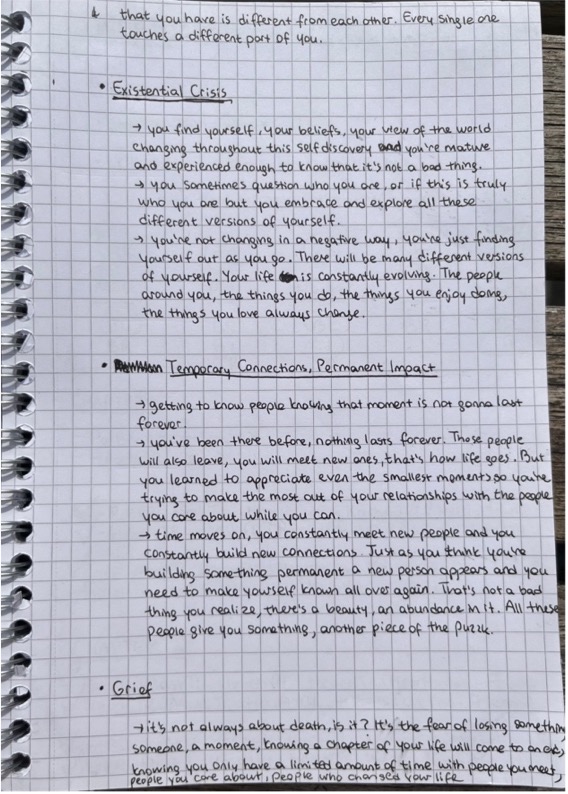
At that moment, I decided this was the story I wanted to tell. Like most of my friends, I had been through the same existential roller coaster before, and I’m sure most people also do. This was a story that could touch people and hopefully help them through tough times.
With that, the hard part was done, coming up with an idea. At least, that’s what I thought at the time.
Now that I had a story, I needed to think of ways to clearly implement the feelings and concepts I wanted to pass on. That took a lot of iterations, scribbling, abandoned pages, and confusion. I knew what I wanted to tell, but how do I tell it? That was when I finally understood the difference between story and narrative design.
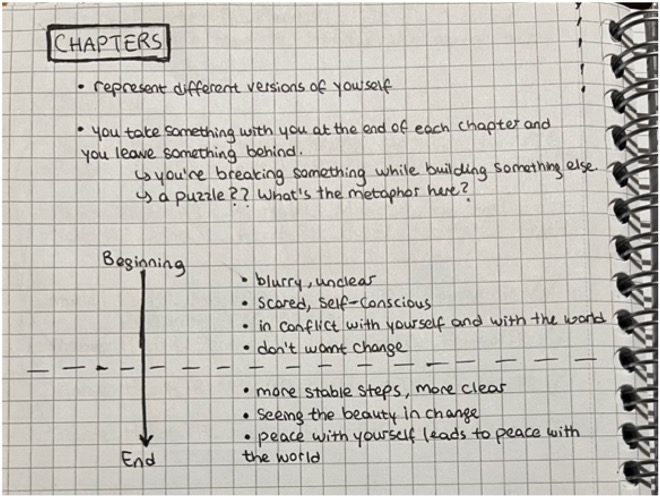

First, I focused on the game's purpose—making people feel something. I wanted to create an experience that would draw the players into the story. I wanted the stream of consciousness of the character and the player to be one.
When explaining an abstract concept, metaphors and analogies are your best friends to bring your floating ideas down to earth. I explored different metaphors before deciding that puzzle pieces would be the perfect fit for what I was trying to tell: we’re made up of different versions of ourselves. We don’t exist only as a single Self; we’re a combination of these different versions, like pieces of a puzzle.
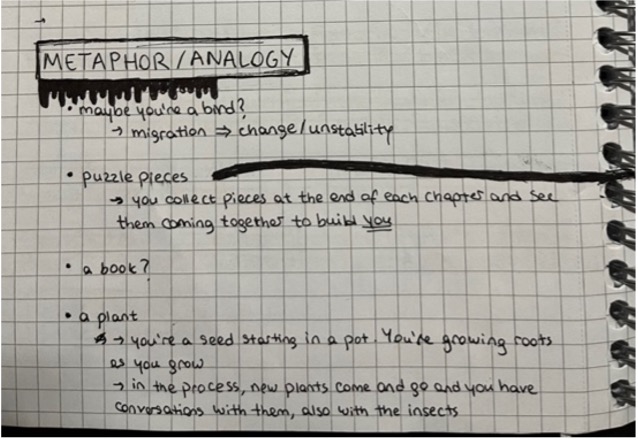
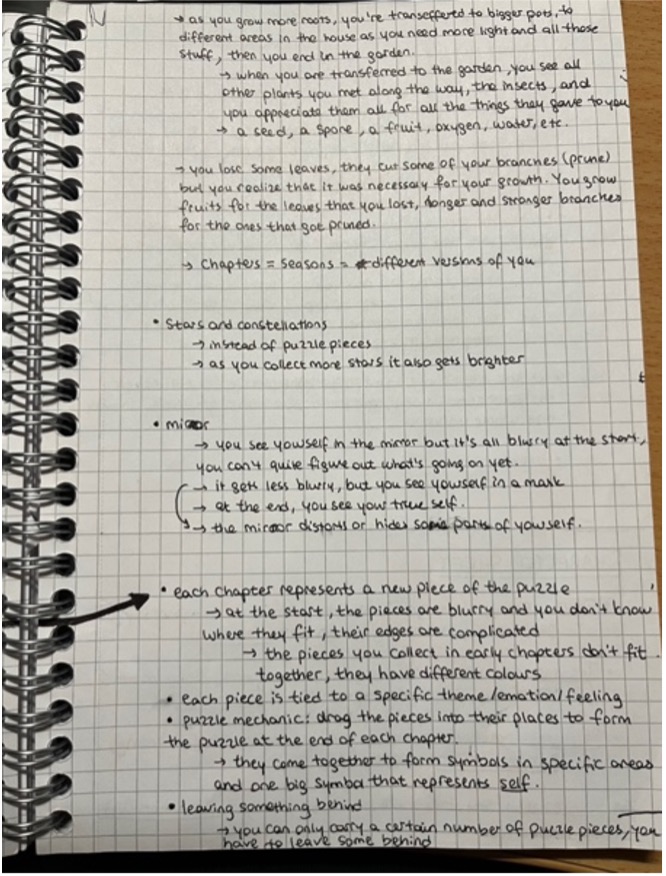
That was a good start, but it only brought more questions: What does this puzzle represent? What are the pieces? How do they come together? What do they build?
That’s when I took a break on narrative design and switched back to the story. This was one of the challenging parts of this development process, wearing different hats but not knowing when to wear which. Does narrative design come first, do I first need to figure out the system and the mechanics, or should I finish writing all the dialogues and branches?
Wait.
Did someone say branches?
I still don’t know the answer to what comes first, though I believe that it’s neither. It all happens interconnectedly. Luckily, while thinking about all these and drafting the first few dialogues, I found the answer to what the puzzle pieces would build.
Deciding to represent the Self with a tree was a Eureka moment for me. Yes, we carry different versions of ourselves, but we also carry what we get from people around us. The pieces that make up those versions are our experiences, our masks, our roots.
That final tree piece completed the narrative cycle. You follow the story through a series of dialogues either with yourself or other people, collect emotions from those interactions, and build a version of the character you’re playing –or yourself, depending on how successful I was at dragging you into the story.
You know how they say to know your opponent before making your move? I think that applies to narrative design, too. The opponent is the tool you will use, and the move is, well, the narrative.
Drunk with the success of coming up with the smartest design idea known to humans (yes, I’m being extra), I started writing the story before even opening Twine.
That was a mistake.
Since this game aimed to evoke genuine feelings, I wanted to use the power of dialogue to convey emotions through words. That was one of the main reasons I chose Twine as a text-based platform. That also brings some limitations, but I was up for experimenting with them.
I wanted the players to feel the story, to become a part of it like they were experiencing it in person. It’s easier to create this feeling of immersion when the game possesses rich aesthetics, but for this game, all I needed was rich text and decent sound design that would support the environment. I could also use the text links to create this illusion, like taking a picture. I aimed to give the feeling that you’re walking down the street with a sweet song on your headphones. It’s you, your memories, and your thoughts. You’re daydreaming as the sun goes down.
By its nature, the narrative had multiple branches. Creating those branches in text was fairly easy, especially if colored text makes you happy. But it was a pain to configure them in Twine. I even had to modify some dialogues and branches to make them work how I wanted to. All those hours spent on writing were wasted.
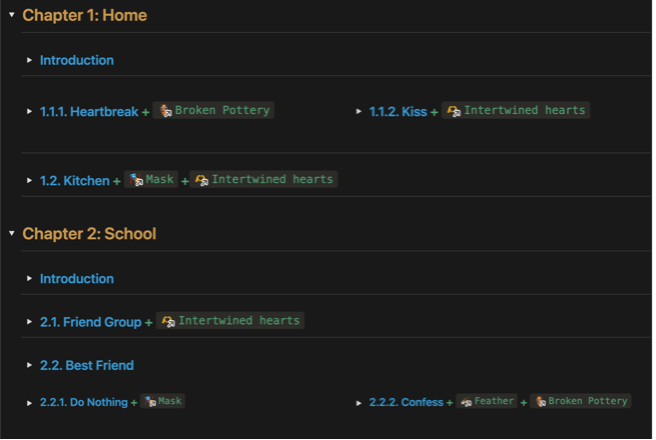
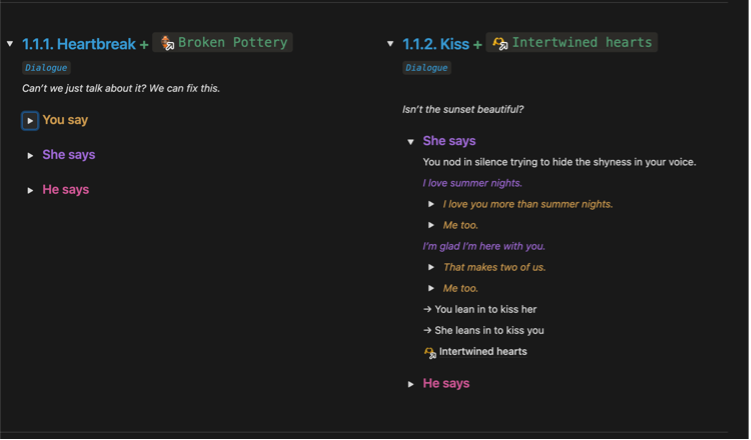
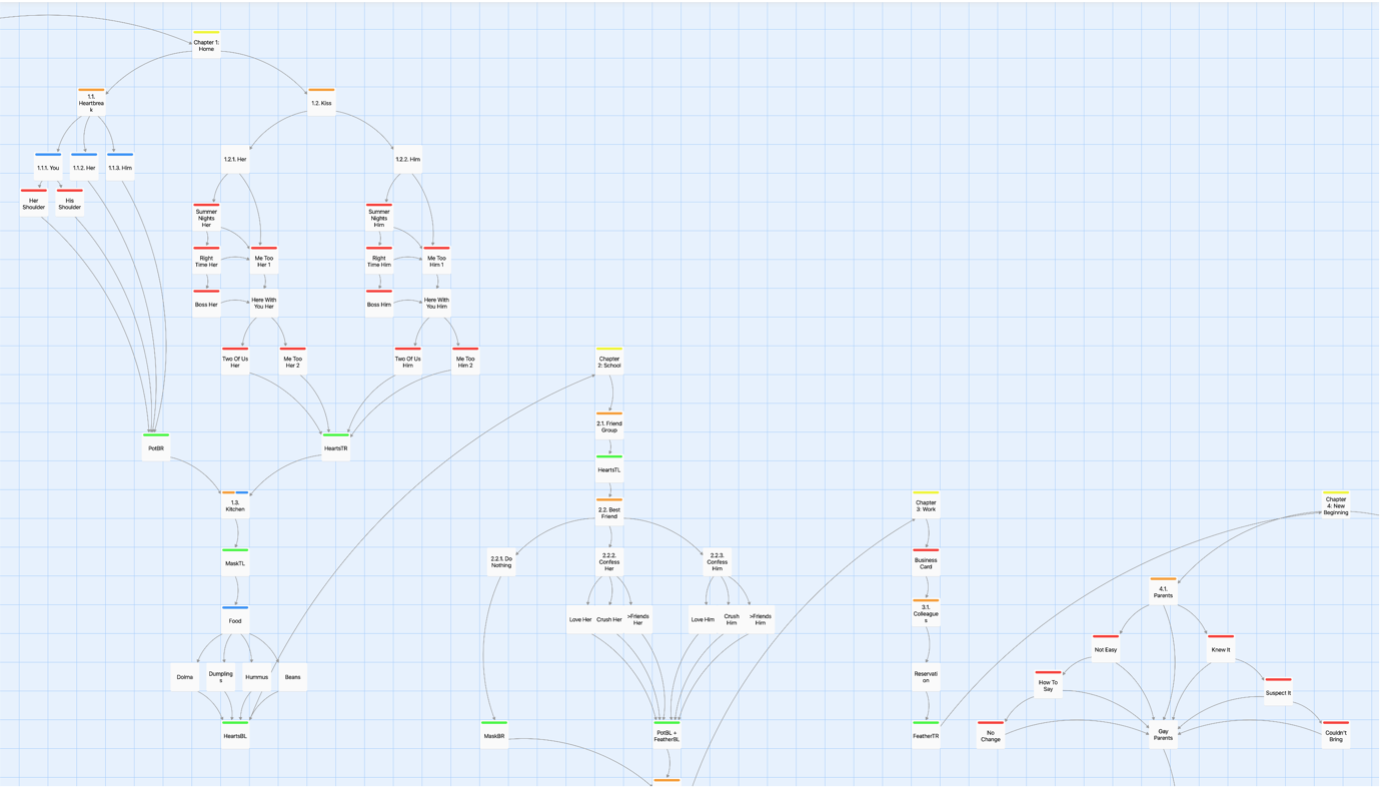
On the other hand, those frustrating times helped me learn Twine better. Once I figured out how to do something, it was easier to implement it to the whole game because the structure of the scenes was very similar.
One thing no one tells you, though, is how hard it is to playtest a branching narrative.
In this game, branches don’t represent multiple endings or different storylines. They’re connected with the core mechanic of the game, the formation of the Self. The choices you make lead you to collect different puzzle pieces, hence, form different versions of the tree.
Since the narrative is about accepting whatever version you’re taking with you to your new life, there are no restart or chapter selection options. And I don’t trust Twine enough to not go through every possible branch, so I had to play through eight branches, multiple times. I still don’t know how to tackle this, but I promise to update this postmortem once I figure it out, because I wouldn’t wish this upon my worst enemy.
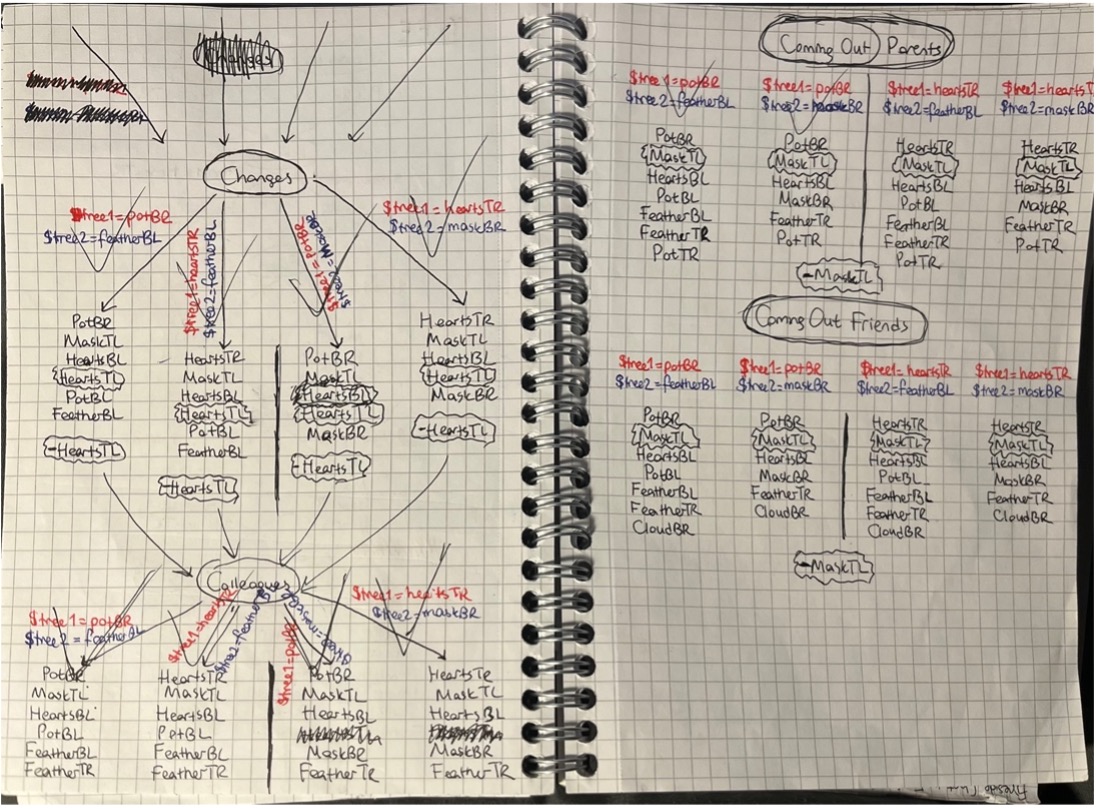
Playtesting definitely didn’t go well, because the problem wasn’t only the branching narratives. Although the story is fictional, it was inspired by my personal experiences. When a game contains heavy personal inspirations, it’s not easy to share it with people. There are only a few you can trust that story with, and those are the people closest to you, which is the worst group of playtesters. So, I guess I’ll receive the real judgment of the game when it’s seen and played by others.
The only upside was that I knew one of my playtesters had dyslexia, so I designed the scenes thinking about her. We usually don’t prioritise accessibility, especially if there are pressing deadlines. It was nice to have this opportunity to make it a part of my game design.
Shout out to my playtester friends who made me feel safe enough to be vulnerable and thank you, for playing my game and reading this postmortem!
AI was not used in any part of this game.
All sound effects were downloaded from freesound.org
Did you like this post? Tell us
Leave a comment
Log in with your itch.io account to leave a comment.